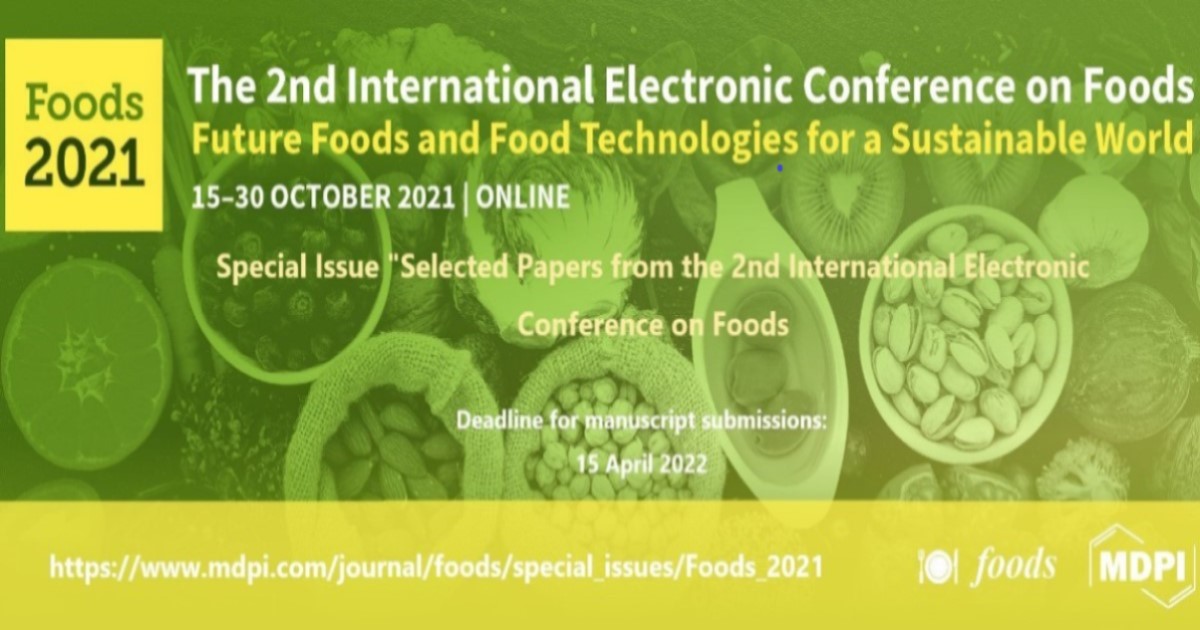The 2nd International Electronic Conference on Foods - "Future Foods and Food Technologies for a Sustainable World" (Foods 2021)
A special issue of Foods (ISSN 2304-8158).
Deadline for manuscript submissions: closed (15 April 2022) | Viewed by 36012

Special Issue Editors
Interests: microbiology; pathogenesis; host–pathogen interaction; nanobiotechnology; food safety
Special Issues, Collections and Topics in MDPI journals
Interests: food emulsions; structure-function in foods; biodegradable packaging; food engineering; micro/nano encapsulation; food powders/food drying
Special Issues, Collections and Topics in MDPI journals
Interests: food science and technology; phytochemistry; bioactive compounds; health-promoters, functional ingredients; natural foods; healthy foods; energy metabolism (obesity and diabetes); human nutrition; wellbeing
Special Issues, Collections and Topics in MDPI journals
2. Research Institute in Food Nutrition and Food Safety, Universitat de Barcelona, Av. Prat de la Riba 171, Edifici Recerca (Gaudí), E-08921 Santa Coloma de Gramenet, Spain
Interests: food authentication; food characterization; food classification; food fraud identification; secondary metabolites; polyphenols; foodomics; bioactive compounds; liquid chromatography; mass spectrometry; high resolution mass spectrometry; ambient mass spectrometry; capillary electrophoresis; chemometrics
Special Issues, Collections and Topics in MDPI journals
Interests: chemosensory perception; multisensory interaction; sensory science; emotion science; neuro-psychophysiology; food choice; eating behavior; sensory marketing
Special Issues, Collections and Topics in MDPI journals
Interests: food authenticity; food chemistry; molecular biology approaches applied to food authentication and GMO detection; plant food supplements; bioactive compounds; antioxidant activity; antimicrobial activity; chromatography; development of analytical methods
Special Issues, Collections and Topics in MDPI journals
Interests: food safety; food security and sustainability; aquaculture; feed and food; natural toxins; drug residues; antibiotics; chemical contaminants; climate change; (bio) analytical chemistry; biosensors; diagnostics; immunoassays; mass spectrometry
Special Issues, Collections and Topics in MDPI journals
Interests: food chemistry; safety; food safety; nutraceuticals; nanonutraceuticals; recovery from byproducts of the food industry; food contaminants; food supplements; contaminants; risk assessment; mycotoxins and secondary metabolites; chemistry and food education
Special Issues, Collections and Topics in MDPI journals
Interests: functional foods; bioactive compounds; antioxidant capacity; sterols; phytochemicals; bioaccessibility; bioavailability; bioactivity; cell cultures; chemoprevention; oxidative stress; eryptosis; food by-products
Special Issues, Collections and Topics in MDPI journals
Interests: active antimicrobial and biodegradable packaging; polymer science; wastewater treatment; biomass and waste valorization
Special Issues, Collections and Topics in MDPI journals
Interests: food technology; food engineering; food safety; food quality; extra virgin olive oil; mycotoxins; fermented foods
Special Issues, Collections and Topics in MDPI journals
Interests: food-borne pathogens; shelf life; essential oils; biofilm; food preservation
Special Issues, Collections and Topics in MDPI journals
Special Issue Information
Dear Colleagues,
This Special Issue comprises selected papers from the Proceedings of The 2nd International Electronic Conference on Foods - "Future Foods and Food Technologies for a Sustainable World" (Foods 2021), held on 15–30 October 2021, on https://foods2021.sciforum.net/, an online platform for hosting scholarly e-conferences and discussion groups.
Through Foods 2021, we aim to provide leading scientists working in the field of food research with a brand-new tool for sharing research in an online environment that will preserve the same standards and structure as expected of traditional conferences but which will be more inclusive by breaking the cost and time barriers that prevent participation in international conferences. The conference has been divided into 9 themes, as listed below:
Session 1: COVID-19 Risks to Global Food Security and Sustainability
Session 2: Novel Technologies and Future Food
Session 3: Food Nutrition and Human Health
Session 4: Food Analysis and Foodomics
Session 5: Food Chemistry and Biochemistry
Session 6: Consumers’ Preferences and Food Choices
Session 7: Food Microbiology and Fermentation
Session 8: Food Packaging and Preservation
Session 9: Innovative Food Additives and Ingredients
Selected papers that have attracted the most interest on the web or that provide a particularly innovative contribution have been gathered for publication. These papers have been subjected to peer review and are published with the aim of a rapid and wide dissemination of research results, developments, and applications. We hope this Conference Series will grow rapidly in the future and become recognized as a new way and venue by which to present new developments related to the field of food science and functional foods.
Prof. Dr. Arun K. Bhunia
Prof. Dr. Benu P. Adhikari
Dr. Diego A. Moreno
Prof. Dr. Oscar Núñez
Dr. Han-Seok Seo
Prof. Dr. Joana S. Amaral
Prof. Dr. Katrina Campbell
Prof. Dr. Antonello Santini
Dr. Antonio Cilla
Dr. Marlene Cran
Prof. Dr. Theodoros Varzakas
Prof. Dr. Antonello Paparella
Guest Editors
Manuscript Submission Information
Manuscripts should be submitted online at www.mdpi.com by registering and logging in to this website. Once you are registered, click here to go to the submission form. Manuscripts can be submitted until the deadline. All submissions that pass pre-check are peer-reviewed. Accepted papers will be published continuously in the journal (as soon as accepted) and will be listed together on the special issue website. Research articles, review articles as well as short communications are invited. For planned papers, a title and short abstract (about 100 words) can be sent to the Editorial Office for announcement on this website.
Submitted manuscripts should not have been published previously, nor be under consideration for publication elsewhere (except conference proceedings papers). All manuscripts are thoroughly refereed through a single-blind peer-review process. A guide for authors and other relevant information for submission of manuscripts is available on the Instructions for Authors page. Foods is an international peer-reviewed open access semimonthly journal published by MDPI.
Please visit the Instructions for Authors page before submitting a manuscript. The Article Processing Charge (APC) for publication in this open access journal is 2900 CHF (Swiss Francs). Submitted papers should be well formatted and use good English. Authors may use MDPI's English editing service prior to publication or during author revisions.

















